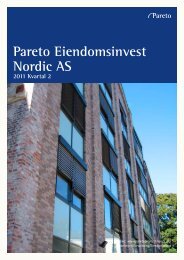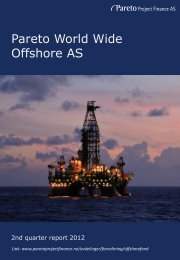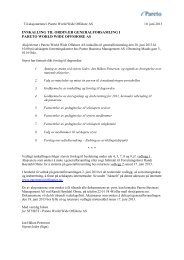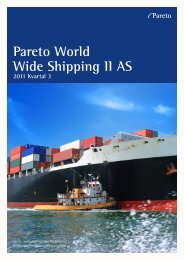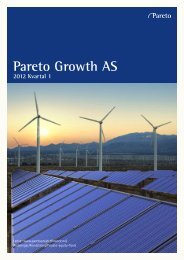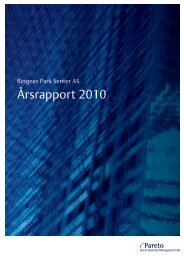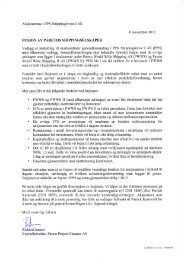Pareto World Wide Offshore AS - Pareto Project Finance
Pareto World Wide Offshore AS - Pareto Project Finance
Pareto World Wide Offshore AS - Pareto Project Finance
Create successful ePaper yourself
Turn your PDF publications into a flip-book with our unique Google optimized e-Paper software.
<strong>Pareto</strong> <strong>World</strong> <strong>Wide</strong><br />
<strong>Offshore</strong> <strong>AS</strong><br />
2011 Kvartal 3<br />
Lenke: www.paretoprojectfinance.no/<br />
Avdelinger/Forvaltning/<strong>Offshore</strong>fond
Forvaltningsteamet<br />
Per-Christian Nicolaisen Richard Jansen Johan Anker-Rasch Patrick Kartevoll<br />
Ansvarlig Forvalter Ansvarlig Forvalter Forvalter Forvalter/Forretningsfører<br />
Eiendom Shipping/<strong>Offshore</strong> Eiendom/Shipping/<strong>Offshore</strong> Shipping/<strong>Offshore</strong><br />
Tlf: + 47 22 01 58 08 Tlf: + 47 22 01 58 96 Tlf: + 47 22 01 58 73 Tlf: + 47 22 01 58 79<br />
E-post: nico@pareto.no E-post: richard.jansen@pareto.no E-post: jar@pareto.no E-post: patrick@pareto.no<br />
Jonathan Andreas Barfod Hans Gunnar Martinsen Fredrik Jansen Sommernes<br />
Forvalter Forretningsfører Forretningsfører<br />
Eiendom/Shipping/<strong>Offshore</strong> Eiendom Eiendom<br />
Tlf: + 47 22 01 58 46 Tlf: + 47 22 01 58 88 Tlf: + 47 22 01 58 06<br />
E-post: jab@pareto.no E-post: hgm@pareto.no E-post: fjs@pareto.no<br />
Dronning Mauds Gate 3, P.O. Box 1396 Vika, NO-0114 Oslo, Norway, Tlf: 22 87 87 00, www.pareto.no
<strong>Pareto</strong> er en uavhengig og ledende aktør i<br />
det norske markedet for finansielle tjenester.<br />
Selskapet har kontorer i Oslo, Stavanger, Bergen,<br />
Trondheim, Kristiansand, Bryne, Singapore<br />
og New York. <strong>Pareto</strong> ble stiftet i 1986, og har<br />
utviklet seg til å bli et konsern med et omfattende<br />
produktspekter. Selskapet har cirka 450 ansatte.<br />
Den sterke utviklingen er muliggjort gjennom<br />
dedikerte og dyktige medarbeidere, skarpt<br />
fokus på å utvikle gode produkter, kontrollert<br />
vekst og ikke minst ved at våre kunder og<br />
forretningsforbindelser har vist oss tillit.<br />
<strong>Pareto</strong> <strong>Project</strong> <strong>Finance</strong> <strong>AS</strong><br />
<strong>Pareto</strong> Business Management <strong>AS</strong><br />
<strong>Pareto</strong> Securities <strong>AS</strong><br />
<strong>Pareto</strong> Forvaltning <strong>AS</strong><br />
<strong>Pareto</strong> Bassøe Shipbrokers <strong>AS</strong><br />
<strong>Pareto</strong> Bank <strong>AS</strong>A<br />
<strong>Pareto</strong> Wealth Management <strong>AS</strong><br />
<strong>Pareto</strong> <strong>Offshore</strong> <strong>AS</strong><br />
<strong>Pareto</strong> Dry Cargo <strong>AS</strong><br />
<strong>Pareto</strong> PPN <strong>AS</strong><br />
JGO Shipbrokers <strong>AS</strong><br />
<strong>Pareto</strong> Forsikringsmegling <strong>AS</strong>
Forvalters kommentar<br />
Uroen i finansmarkedene gjennom tredje kvartal signaliserer<br />
svakere vekst i offshore markedene fremover. Det langsiktige<br />
bildet er fremdeles sterkt og vil fortsette å bli drevet<br />
av behovet for å erstatte fallende, eksisterende reserver<br />
med nye. Olje er og blir en knapp ressurs, noe som er en<br />
av årsakene til at oljeprisen har vært forbausende sterk på<br />
tross av all uroen. Aktiviteten innenfor offshore har også<br />
fortsatt å øke og man har sett nye nivåer både på rater og<br />
transaksjonsverdier.<br />
Allikevel er det sannsynlig at svakere global økonomisk<br />
vekst og gjeldskrisen i PIGS-landene vil ha negativ innflytelse<br />
på utsiktene på kort til mellomlang sikt. Den umiddelbare<br />
effekten kan man allerede se ved at bankene er<br />
mer restriktive på utlån enn før sommeren, samtidig som<br />
lånekostnadene øker. Det er et stort finansieringsbehov<br />
fremover både for oljeselskaper og oljeservice selskaper, slik<br />
at dette vil redusere veksttakten. Lavere generell økonomisk<br />
vekst vil også påvirke hvor aggressive oljeselskapene ønsker<br />
å være når investerings-budsjettene skal settes de kommende<br />
år, som igjen begrenser hvor raskt markedene vokser.<br />
Oppgangen vi så i 2010 har fortsatt å styrke seg i 2011,<br />
men det virker nå mer sannsynlig med en utflating på kort<br />
til mellomlang sikt. Det langsiktige bildet er for sterkt til<br />
at en ny nedgang virker realistisk. Vi ser at rateoppgangen<br />
har spredd seg til flere segmenter, fra moderne jack-ups til<br />
eldre jack-ups, til midwater rigger og til dypvannsrigger. I<br />
supplymarkedene har ratene skutt voldsom fart gjennom<br />
kvartalet. Tender aktiviteten er rimelig høy i alle segmenter,<br />
så det ser ut til at man er sikret at aktiviteten neste år<br />
blir høyere enn i år. Muligens flater det noe ut deretter,<br />
men vi beveger oss uansett i riktig retning.<br />
I våre prosjekter har vi notert en klar bedring i interessen<br />
både for å leie enheter og for å kjøpe enheter. Det er<br />
flere og flere interessenter i markedet og betalingsvilligheten<br />
øker, både for kjøp og for leie. Dette har vesentlig<br />
betydning for prosjektene i <strong>Pareto</strong> <strong>World</strong> <strong>Wide</strong> <strong>Offshore</strong><br />
<strong>AS</strong> («PWWO») og forvalter er mer optimistisk enn tidligere<br />
på å få gjort realiseringer eller slutninger som øker<br />
aksjonærenes verdier.<br />
Forvalter er derfor fortsatt positiv til verdiutviklingen i<br />
PWWO.<br />
Viktige hendelser for PWWOs<br />
investeringer i løpet av tredje kvartal<br />
Songa Eclipse Ltd (Deepwater Driller Ltd)<br />
PWWO har solgt sine aksjer i selskapet til hovedeier<br />
Songa <strong>Offshore</strong> i tredje kvartal. Som godtgjørelse mottok<br />
PWWO USD 17,6m i kontanter samt en bonusavtale som<br />
gir krav på ytterligere vederlag i løpet av en 18 måneders<br />
periode fra levering, avhengig av verdiutvikling på riggen<br />
og opptjent kontantstrøm. Riggen vil starte på en 18<br />
måneders kontrakt med Total utenfor Angola i november<br />
i år til en rate på ca USD 435.000 per dag. Totalverdien<br />
på bonusavtalen kan innebære en oppside i forhold til<br />
siste verdivurdering av prosjektet pr 30.6.11. Samtidig har<br />
PWWO mottatt et krav fra Larsen Oil & Gas Ltd på deler<br />
av salgsprovenyet. Dette kravet bestrides, men man har<br />
besluttet å holde midler til side som dekning. Det er sannsynlig<br />
at kravet vil bli gjenstand for rettslig behandling,<br />
men tidspunktet for dette vites ikke i skrivende stund.<br />
Bassdrill Alpha Ltd<br />
Aksjonærene deltok i en mindre emisjon på USD 2,5m i<br />
august for å finansiere oppstart av en ny kontrakt for riggen.<br />
Den er nå sluttet til Total Kongo i en fast periode på<br />
8–9 måneder, med opsjoner på forlengelse. Raten er opp i<br />
overkant av 15 % fra forrige kontrakt. Det jobbes med en<br />
refinansiering av obligasjonslånet med 17,5 % rente som<br />
forfaller mot slutten av året, noe som vil bedre egenkapitalavkastningen<br />
betydelig.<br />
Middle East Jack-up Ltd<br />
Riggen blir levert i oktober. Det foreligger konkret kjøpsinteresse<br />
for riggen fra flere hold og på nivåer som er<br />
vesentlig opp i forhold til tidligere i år. Samtidig er det<br />
gode muligheter for befraktning på akseptable nivåer.<br />
PWWO har satt av midler for å ta levering uten ytterligere<br />
opptak av gjeld. Forvalter venter en avklaring på dette prosjektet<br />
før jul.<br />
Parbarge IS<br />
Barge virksomheten til Marine Subsea blir flyttet over i<br />
et nytt selskap som heter African <strong>Offshore</strong> Services og
som drives av den tidligere ledelsen i Marine Subsea. Våre<br />
sluttbrukere og kontraktsbetingelser forblir de samme.<br />
Totalt sett er dette en god løsning for prosjektet ettersom<br />
motpartssikkerheten anses som å være bedre, samtidig som<br />
lønnsomheten blir den samme.<br />
Neptune Subsea og Neptune <strong>Offshore</strong><br />
Man har besluttet å ta levering av begge skipene til rabatterte<br />
priser. De leveres i oktober og november. Det jobbes<br />
med befraktningsmuligheter, både korte og lange, og<br />
interessen har vokst betydelig etter at det ble klart at skipene<br />
blir levert. Neptune Subsea er kapitalisert godt nok<br />
opp til at skipene kan være uten inntjening i nesten ett år<br />
uten at man behøver ytterligere tilførsel av kapital. Hva<br />
som skjer med Neptune <strong>Offshore</strong> videre, utover eierandelen<br />
i Neptune Subsea, avhenger av hvilken type befraktning<br />
skipene får.<br />
Vestland Seismic IS<br />
Motpartssikkerheten er vesentlig bedret ettersom befrakter<br />
RXT har inngått en avtale med en industriell partner som<br />
har skutt inn USD 10 millioner i morselskapet og USD<br />
20 millioner i et felles eiet datterselskap. Markedsutsiktene<br />
har også bedret seg og seismikk skipet som Vestland eier<br />
har sluttet ut året.<br />
Ekstraordinært utbytte<br />
Etter salget av aksjene i Songa Eclipse Ltd vedtok generalforsamlingen<br />
et ekstraordinært utbytte på NOK 10<br />
per aksje. Dette ble betalt ut til aksjonærene i september.<br />
Dette var første utbytte fra PWWO siden oppstart. Ny<br />
VEK justert for utbytte er således NOK 113 per aksje.<br />
Volatil US dollar<br />
Som presisert i prospekt (og Informasjonsmemorandum)<br />
er investeringer som gjøres i valuta utsatt for svingninger<br />
mellom den underliggende valutaen og NOK. PWWO<br />
foretar ingen valutasikring, og dette innebærer at endringer<br />
i valutakurser påvirker den verdijusterte egenkapitalen<br />
i de underliggende investeringene. Ca 72 % av verdijustert<br />
egenkapital i porteføljen er eksponert mot USD (per 30.<br />
september 2011). Lavere USD hadde pr 30. juni 2011 hatt<br />
en negativ effekt på rapportert VEK i norske kroner på ca<br />
6 %. Siden da har USD/NOK steget med ca 3 %.
Verdi- og kapitalutvikling<br />
Kursutvikling<br />
Beregnet verdijustert egenkapital («VEK») for PWWO per<br />
30. juni 2011 er på NOK 123 per aksje, basert på en valutakurs<br />
USD/NOK på 5,3822. Justert for utbetalingen på<br />
NOK 10 per aksje i september er denne nå på NOK 113<br />
per aksje.<br />
Kursutviklingen som rapporteres for PWWO er basert<br />
på verdijustert egenkapital. Videre er verdivurderingen av<br />
de underliggende investeringene basert på innhentet markedsverdi<br />
fra megler(e)/tilrettelegger(e), hvor anerkjente<br />
verdivurderingsprinsipper og bransjemessige standarder<br />
blir lagt til grunn.<br />
Annenhåndsomsetning<br />
Det er utstedt totalt 4.370.473 aksjer i PWWO. <strong>Pareto</strong><br />
<strong>Project</strong> <strong>Finance</strong> <strong>AS</strong> («PPF») legger til rette for aktiv annenhåndsomsetning<br />
av aksjer. Siste omsatte kurs er NOK 90<br />
per aksje (18.10.2011), noe som også bekreftes gjennom<br />
omsetninger gjort i feederselskapet <strong>Pareto</strong> <strong>Offshore</strong>kapital.<br />
Investorer som ønsker å kjøpe eller selge sine aksjer kan ta<br />
kontakt med sin rådgiver.<br />
Direkteavkastning<br />
Ved realisasjon av skip/rigger eller andeler/aksjer i selskaper<br />
som eier skip/rigger skal provenyet normalt utbetales<br />
til investorene i PWWO. I tråd med dette ble det betalt<br />
ut et ekstraordinært utbytte på NOK 10 pr aksje i september<br />
i.f.m. salget av aksjene i Songa Eclipse Ltd. Styret har<br />
imidlertid anledning til å tilbakeholde hele eller deler av<br />
eventuell salgsproveny som arbeidskapital. Styret kan også<br />
benytte provenyet til å foreta nye investeringer og/eller<br />
oppfølgningsinvesteringer i eksisterende prosjekter.<br />
Investeringstakt og kapitalutvikling<br />
Kommittert kapital i PWWO var opprinnelig NOK 881<br />
millioner. PWWO er for tiden investert i 20 enheter og<br />
har en kontantbeholdning på ca. NOK 155 millioner. Av<br />
disse er ca. NOK 23 millioner gjenstående innbetalinger<br />
på allerede kommitterte investeringer, mens resterende<br />
NOK 132 millioner er fri kapital som hovedsaklig vil bli<br />
brukt til oppfølging av eksisterende prosjekter. PWWO vil<br />
være tilbakeholdne med bruk av kapital til nye investeringer<br />
inntil det har kommet avklaringer i prosjektene som<br />
foreløpig ikke er fullfinansiert.
«Siste verdijusterte egenkapital er NOK 113 per<br />
aksje, justert for utbytte på NOK 10 per aksje<br />
som ble utbetalt i september»<br />
Kursutvikling <strong>Pareto</strong> <strong>World</strong> <strong>Wide</strong> <strong>Offshore</strong> <strong>AS</strong>*<br />
NOK<br />
240<br />
220<br />
200<br />
180<br />
160<br />
140<br />
120<br />
100<br />
80<br />
Emisjon I 15.06.07<br />
(USD/NOK 6,08)<br />
Emisjon II 19.10.07<br />
(USD/NOK 5,63)<br />
Emisjon III 22.02.08<br />
(USD/NOK 5,44)<br />
VEK 30.06.08<br />
(USD/NOK 5,15)<br />
VEK 01.11.08<br />
(USD/NOK 5,95)<br />
VEK 31.12.08<br />
(USD/NOK 7,01)<br />
VEK 01.05.09<br />
(USD/NOK 6.60)<br />
VEK 01.11.09<br />
(USD/NOK 5.74)<br />
VEK 30.06.10<br />
(USD/NOK 6.50)<br />
VEK 31.12.10<br />
(USD/NOK 5.86)<br />
VEK 30.06.11<br />
(USD/NOK 5.39)<br />
Ex utbytte 08.09.11<br />
* Omfatter ikke omsetning i annenhåndsmarkedet.<br />
Kapitalutvikling<br />
MNOK<br />
1000<br />
900<br />
800<br />
700<br />
600<br />
500<br />
400<br />
300<br />
200<br />
100<br />
0<br />
Kommitert kapital VEK Fond Utbetaling<br />
Fri investeringskapital Gjenstående innbetalinger VEK prosjekter*<br />
* korrigert for latent skatt/skattefordel
<strong>Offshore</strong>porteføljen<br />
PWWO har som nevnt investert/bundet opp investeringer<br />
i andeler i 20 enheter fordelt på segmentene forsyningsskip,<br />
slepe- og ankerhåndteringsfartøy, flotell (innkvarterings-<br />
og serviceenheter), lekterrigg, halvt-nedsenkbare<br />
rigger, oppjekkbare rigger, IMR skip (Inspection Maintenance<br />
Repair) og seismikkfartøyer. Vektet certepartilengde<br />
på porteføljen er ca. 2,4 år (inkludert nybygg uten<br />
certeparti som leveres frem i tid).<br />
Finansiering<br />
Som nevnt i kvartalsrapport for tredje kvartal 2011 har<br />
MEJU sikret finansiering frem til levering, gjennom utstedelse<br />
av obligasjonslånet på USD 50 millioner. I dette<br />
prosjektet gjenstår det USD 30 millioner å finansiere ved<br />
levering, og noe av dette kan komme i form av ytterligere<br />
egenkapital. PWWO har satt av midler for å dekke sin<br />
andel av dette.<br />
PWWOs transaksjoner i løpet<br />
av tredje kvartal<br />
Kjøp<br />
PWWO har ikke gjort noen investeringer i nye prosjekter<br />
siden sommeren 2008. Imidlertid har selskapet gjort oppfølgingsinvesteringer<br />
i eksisterende prosjekter. Gjennom<br />
tredje kvartal ble det innbetalt NOK 5 millioner i prosjektet<br />
Bassdrill Alpha Ltd. Innbetalingen er gjort i forbindelse<br />
PWWOs prosjekter<br />
Kjøpsdato Prosjekt / selskap Antall enh. Segment Byggeår (oppgradert) Certeparti slutt<br />
24-05-07 Asian <strong>Offshore</strong> III IS 6 Enkle PSV/AHTS Asia 2009 30-09-16<br />
19-11-07 Equinox <strong>Offshore</strong> Accomodation Ltd 2 Accomodation 1979-1985 (2008/2009) 26-04-13<br />
20-11-07 Peregrine I LLC 0 Drillship 1983 (1995, 2005, 2009) 31-12-14<br />
18-03-08 Neptune <strong>Offshore</strong> <strong>AS</strong> 1 IMR 2002 (2008)/2010<br />
18-03-08 Neptune Subsea IS 2 IMR 2010<br />
19-03-08 Vestland Seismic IS 1 Seismic 1995 (2008) 01-09-18<br />
22-08-08 Bukhit Timah <strong>Offshore</strong> DIS 3 Enkle PSV/AHTS Asia 2009-2010 01-07-20<br />
19-06-08 ParBarge IS 2 Accomodation 2008 26-07-18<br />
20-06-08 Bassdrill Alpha Ltd 1 Tender Rig 2009 30-06-12<br />
03-07-08 Songa Eclipse Ltd 1 Semi Submersible Rig 2011 01-04-13<br />
25-07-08 Middle East Jackup Ltd (MEJU) 1 Jack-up Rig 2010<br />
Total 20 2,4<br />
*VEK på de underliggende prosjektene er presentert før eventuell latent skatt.
Certeparti- og segmentfordeling (basert på VEK)<br />
Timecharter 32 %<br />
Jack-up<br />
Rig 12 %<br />
Enkle PSV/<br />
AHTS Asia<br />
12 %<br />
Accomodation 10 %<br />
Bareboat 30 %<br />
Tender Rig 24 %<br />
IMR 27 %<br />
Spot/Asset Play 24 %<br />
Annet 14 %<br />
Semi Submersible Rig 7 %<br />
Seismic<br />
8 %<br />
med emisjon i selskapet og er i henhold til tidligere kommitteringer.<br />
Salg<br />
Aksjene i Songa Eclipse Ltd ble som nevnt tidligere solgt<br />
for USD 17,6m med tillegg av en bonusavtale som kan<br />
sikre ytterligere oppgjør avhengig av riggens verdiutvikling<br />
og inntjening i løpet av en 18 måneders periode fra<br />
levering.<br />
Utbetalinger fra underliggende prosjekter<br />
PWWO har ikke mottatt utbytte fra underliggende investeringer<br />
i løpet av tredje kvartal.<br />
Definisjoner<br />
I denne kvartalsrapporten har nedenstående utrykk følgende<br />
betydning, med mindre annet er direkte uttalt eller<br />
fremgår av sammenheng. De nedenstående definisjonene<br />
gjelder også for de foregående sidene i denne kvartalsrapporten.<br />
Definisjoner:<br />
PWWO <strong>Pareto</strong> <strong>World</strong> <strong>Wide</strong> <strong>Offshore</strong> <strong>AS</strong><br />
VEK Verdijustert egenkapital<br />
PPF <strong>Pareto</strong> <strong>Project</strong> <strong>Finance</strong> <strong>AS</strong><br />
Type kontrakt Befrakter Disponent Eierandel VEK'<br />
Bareboat Robert Knutzen Shipholdings Ltd. Bergshav Managment <strong>AS</strong> 12 % 23 312 909<br />
Timecharter N/A N/A 1 % 1 453 200<br />
Timecharter Petrobras S.A. Mike Mullen Energy Equipment Resources Inc. 16 % N/A<br />
Annet N/A N/A 31 % 36 799 315<br />
Spot/Asset play N/A Neptune <strong>Offshore</strong> <strong>AS</strong> 13 % 31 925 085<br />
Bareboat Albatross Shipping Ltd. Klaveness Corporate Services <strong>AS</strong> 35 % 27 037 152<br />
Bareboat Swiber <strong>Offshore</strong> Marine Pte Seabulk <strong>AS</strong> 12 % 17 522 426<br />
Bareboat Marine Subsea <strong>AS</strong> Bergshav Managment <strong>AS</strong> 25 % 33 019 159<br />
Timecharter N/A Bassdrill Ltd. 37 % 84 271 448<br />
Timecharter N/A Songa <strong>Offshore</strong> SE 13 % 24 551 830<br />
Spot/Asset play N/A Swicorp 9 % 39 825 829<br />
319 718 354
Markedskommentar <strong>Offshore</strong> Kilde:<br />
The upturn in oil service markets that we predicted a year<br />
ago appears well underway and according to expectations.<br />
The rising oil price and E&P budgets with 15 % growth<br />
this year have set the tone, and we now see the underlying<br />
markets responding accordingly. Last year was characterized<br />
by utilization and day rate stabilization, with really<br />
only one segment showing upwards movement (modern<br />
jack-ups). This year, there is upwards movement in the utilization<br />
and dayrates in nearly all segments with asset values<br />
following suit. In short, the upturn is both broadening<br />
and strengthening.<br />
The question is how long this will continue, as it is in<br />
stark contrast to the past quarter’s unrest in global financial<br />
markets. These markets are now telling us that we’re likely<br />
to face significantly lower economic growth in the coming<br />
years. This will surely have a dampening effect on the<br />
growth pace in the oil industry and in oil service markets.<br />
On an absolute basis, therefore, things are looking less positive<br />
than some months ago and in the short to medium<br />
term, we are less convinced that we will continue to see<br />
large upticks in dayrates and valuations. The most immediate<br />
effect is already there, through debt financing becoming<br />
less available and more expensive. For a capital intensive<br />
industry like oil & gas, this has significant negative impact.<br />
On a relative basis, though, the oil & gas industry<br />
stands out as a winner. There can be no clearer evidence<br />
than the difference between the performance of the oil<br />
<strong>Pareto</strong> <strong>Project</strong> <strong>Finance</strong> <strong>AS</strong><br />
price and the world’s stock markets (as measured by<br />
MSCI <strong>World</strong> Index) this year. The oil price is up 19 %<br />
YTD, while the stock markets are down 9 %. This outperformance<br />
of 28 %-points is even more intriguing given the<br />
“risk-off” sentiment that has characterized global financial<br />
markets in recent months, something that typically has a<br />
very negative impact on commodity prices. If the oil price<br />
had followed global stock markets south, it would have<br />
traded at USD 87/b, and in a risk-averse environment like<br />
now, probably even lower. Why is this not the case now<br />
The oil price vs MSCI <strong>World</strong> Index<br />
Source: Bloomberg, Digital Look<br />
Our answer is that the oil price is fundamentally driven<br />
and primarily so by the long term energy challenges that
the world is facing. Oil is simply a scarce resource, with<br />
growing demand. Going forward, it will become scarcer<br />
and demand will continue to grow. Perhaps slower in the<br />
coming few years, but the supply / demand equation for<br />
oil will continue to worsen (seen from the consumer’s<br />
perspective), driving a rising need to discover and develop<br />
new resources. That is why the oil price is as robust as<br />
it is, and that is why the activity levels in the oil & gas<br />
industry are continuing to rise, particularly offshore.<br />
Hence, we are still convinced that offshore oil services is<br />
the place to be for the long term investor. Slower growth<br />
is better than no growth and positive returns are better<br />
than no returns, which is what risk free interest rates are<br />
yielding now.<br />
We believe the real upward driver of the oil price will<br />
be rising finding and developing costs. In turn, this will<br />
be driven by an accelerating need to replace the existing<br />
reserve base, which has been shrinking for more than 30<br />
years. The future reserves will be hard and costly to find,<br />
develop and produce. And much more so than the reserves<br />
we’re currently producing from.<br />
We beg investors to consider some staggering numbers:<br />
During the 1990s, the global oil industry spent USD 1.1<br />
trillion and managed to find approximately 137 bn barrels<br />
of new oil reserves. In the period 2000–09, the oil<br />
industry spent USD 2.8 trillion (2.5 times more) and only<br />
managed to discover 143 bn barrels of oil – a mere 4 %<br />
increase over the previous decade. The gap between consumed<br />
oil and new discoveries widened from 112 bn barrels<br />
to 137 bn barrels – an increase of 22 %.<br />
What will happen during the coming decade Firstly, oil<br />
consumption looks set to be 10 % higher than the previous<br />
decade, adding further pressure. For new discoveries<br />
to keep pace with demand, the global discovery rate<br />
would need to double. That seems an impossible feat.<br />
Most likely, the world will struggle even maintaining the<br />
past decade’s discovery rate, meaning that the decline<br />
in existing reserves will accelerate. A steadily increasing<br />
proportion of global production will have to come<br />
from new and more expensive oil. For this production<br />
to come into the market, oil prices must rise. It is really<br />
as simple as that.<br />
Of equal interest is the global expansion of natural<br />
gas demand, which is the world’s fastest growing source<br />
of energy. Nearly all of the demand growth is outside<br />
of the OECD, and is following the early demand patterns<br />
seen for oil in the main emerging economies of the<br />
world. What adds to the demand growth is increased<br />
use of electricity. Bear in mind that ¼ of the world’s<br />
households still has no access to electricity. Natural gas<br />
is an abundant and cheap source of electricity and this is<br />
now showing up in demand numbers in key economies<br />
across the globe.<br />
Chinese natural gas demand<br />
and relative pricing<br />
Source: <strong>Pareto</strong> Securities, BP, IEA<br />
Overall, offshore production of oil and gas is forecast to<br />
grow by 74 % in the coming 20 years. This will constitute<br />
100 % of the total growth in global oil and gas production.<br />
In short, the oil industry will be spending an awful<br />
lot of money in the coming decades and the bulk of it will<br />
be spent offshore. That is excellent news for the offshore<br />
oil services industry.<br />
Global oil & gas production 2010–30<br />
Source: Rystad Energy<br />
The new discoveries in Norway are also relevant for our<br />
outlook, as they rank as the most significant discovery of
new resources globally this year. This has spurred renewed<br />
optimism in Norway, particularly in the Arctic north.<br />
We have already seen seismic acquisition activity respond<br />
almost immediately and additional drilling efforts are<br />
sure to follow in the coming years. In turn, this will<br />
enhance the need to support services from supply vessels<br />
and, when the fields are finally developed, from offshore<br />
construction vessels. Given the harsh environments in<br />
these areas, this will be yet another example of how larger<br />
and more complex units need to be built and the general<br />
need to modernize the offshore fleets to cope with new<br />
demands.<br />
utilization in the premium jack-up market has stabilized<br />
above 95 %, rates are moving upwards more slowly. On<br />
the other hand, utilization and rates for standard jack-ups<br />
have risen substantially with such units commanding rates<br />
that are only 10 %–15 % below premium units. This is a<br />
bullish sign.<br />
Roughly 40 new jack-ups have been ordered for a total<br />
of more than USD 9bn. There are options for another<br />
23 units. Yard prices have risen about 15 % during this<br />
period. In the past quarter, however, ordering activity has<br />
subsided as access to funding has become more limited<br />
and the various players’ appetite for risk has come down.<br />
We are now seeing that some of the yard options are left<br />
undeclared. There is an awful lot of take-out financing to<br />
secure to take delivery of the speculatively ordered rigs,<br />
and right now, risk capital is hard to come by. This may<br />
present larger players with M&A opportunities. In this<br />
respect, the latest transaction of a premium jack-up newbuild<br />
at around USD 220m demonstrates that buyers are<br />
willing to pay top dollars for a modern rig.<br />
Global utilization standard jack-ups<br />
Source: Teknisk Ukeblad, Rystad Energy<br />
Drilling<br />
The drilling industry continues to be brimming with optimism,<br />
as evidenced by the USD 25bn of newbuild orders<br />
that have been placed so far in the cycle. This has been a<br />
response to clients’ needs for modern and more capable<br />
units, as well as to the general, fundamental outlook for<br />
the oil markets. Established rig yards now have full order<br />
books well into 2014 and are quoting higher prices. As a<br />
result, rig owners are sourcing yard slots from more inexperienced<br />
yards at high prices, but with potentially earlier<br />
delivery.<br />
Are there too many rigs on order Investors should take<br />
comfort from the fact that 40 % of the global drilling fleet<br />
is 30 years or older. There is a lot of replacement need in<br />
addition to the demand growth mentioned above. Therefore,<br />
a global orderbook that constitutes approximately<br />
20 % of the current fleet is likely to be insufficient, meaning<br />
that the market looks set to tighten significantly in<br />
the coming 2–3 years. On the other hand, a lot of rigs are<br />
coming out of yards at the same time (2013), which could<br />
result in a temporarily overcrowded buyers’ market. This<br />
potential threat, however, lies some years down the road.<br />
Jack-ups<br />
Global jack-up utilization and dayrates have recovered and<br />
have spread to the market for standard jack-ups. Although<br />
Source: <strong>Pareto</strong> Securities, ODS-Petrodata<br />
Floaters<br />
Leading edge floater dayrates have topped USD 500k/d<br />
for the first time in the cycle, with the majority of ultra<br />
deepwater fixtures being in the USD 450–500k/d range.<br />
Rig availability is very tight in the near term and is<br />
unlikely to ease off until the rigs from the current newbuilding<br />
cycle starts getting delivered from 2013 and<br />
onwards.<br />
Norway is a bright spot in the industry with the abovementioned<br />
fixture of USD 500k/d and Statoil’s award<br />
of 8-year contracts for the use of 2 category D rigs, with<br />
expected delivery during the second half of 2014. The two<br />
large discoveries offshore Norway is likely to add more fuel<br />
to a very tight Norwegian market. Transocean’s acquisition<br />
of Aker Drilling this summer at an implied rig price of<br />
USD 930m/rig is a perfect example of this.
Dayrates floaters<br />
Source: <strong>Pareto</strong> Securities, ODS-Petrodata<br />
Supply market<br />
The North Sea spot market has been very tight during the<br />
summer season and is enjoying a stronger end to the year<br />
than what was the case 12 months ago. This goes both<br />
for PSVs and for AHTS. Norwegian clients have secured<br />
several vessels on long term contracts and a substantial<br />
amount of new tenders are out in the market for additional<br />
tonnage, primarily for large PSVs.<br />
North Sea Spot Rates PSV (> 4,000 dwt)<br />
Source: <strong>Pareto</strong> Research, JGO <strong>Offshore</strong>, Westshore<br />
A cooling factor is the newbuilding ordering activity,<br />
which has risen substantially in line with improving conditions.<br />
A lot of vessels are being ordered, primarily large<br />
PSVs, and the debate is whether there are too many such<br />
vessels on order. We don’t think so, as roughly two thirds<br />
of the order book is targeted markets in the Gulf of Mexico<br />
and Asia Pacific. We also note that ordering activity<br />
has subsided in line with worsening financial and macro<br />
conditions, which will help the market balance going forward.<br />
Broadly speaking the global PSV fleet looks to grow<br />
by an average of 7 % p.a. in the next two years, which is<br />
not very high considering that demand for such vessels<br />
has grown by an average of 10 % per year since 2000. For<br />
AHTS, the order book is smaller, and with an average fleet<br />
growth of 3 % in the next two years, this market looks<br />
likely to tighten. Many now see the AHTS market as the<br />
next in line for substantial newbuilding activity.<br />
Subsea<br />
The subsea vessel market appears to be set for a more<br />
buoyant 2012 than what has been the case this year. The<br />
order books for the larger subsea construction companies<br />
are record high, promising significant activity growth in<br />
coming years. There is also substantial growth in smaller<br />
tenders for a variety of subsea work across the globe as the<br />
oil companies try to catch up with low maintenance levels<br />
in the past two years, continue to work on enhanced<br />
oil recovery plans and prepare for new fields to come on<br />
stream.<br />
Judging by the field development plans in key regions<br />
such as Brazil, West Africa, GoM and Australia, the subsea<br />
industry looks set to enjoy a strong run in the next 5–10<br />
years. Technip, the second largest subsea construction<br />
company, recently said that the Norwegian subsea market<br />
would double in size in the next 3 years. A recovering Gulf<br />
of Mexico is also adding to the picture. Analysts expect<br />
as much as USD 18 bn of large subsea contracts to be<br />
awarded in the next 15 months globally, of which roughly<br />
40 % will for work in West Africa, 20 % in Australia and<br />
20 % in Brazil.<br />
Overall, the demand for subsea vessel services looks set<br />
to increase more than 40 % in the next two years. This<br />
means that vessel shortage could remerge as an important<br />
factor in the not too distant future. Technip has already<br />
said that it is fully booked for 2012 and is looking to add<br />
more vessels. As with most other segments, owners of<br />
modern high quality assets will be well positioned. Moreover,<br />
it is likely that the recently completed merger between<br />
Subsea7 and Acergy will provide space in the market for<br />
new entrants. In turn, these will likely be scouting for<br />
quality assets as a means to gain market share. We have<br />
already seen several new, private equity backed players<br />
emerge, who plan to eat into the big guns’ market shares.<br />
Seismic market<br />
The seismic market has seen a steady rise in demand,<br />
which is now at all time high measured in terms of<br />
acquisition activity. However, the influx of new vessels<br />
into the market has kept a lid on utilization levels and<br />
on dayrates. On the other hand, multi-client demand<br />
has boomed. There are signs that things are about to<br />
improve for the vessel owners. The oil industry appears<br />
to be back in the market with large programs, both for<br />
traditional exploration seismic and for more specialized<br />
surveys like wide azimuth surveys, ocean bottom seismic<br />
surveys and EM surveys. The multi-client market<br />
in the Gulf of Mexico, which is of significant importance<br />
for global vessel utilization, has restarted with four<br />
large multi-client surveys haven been approved. Some<br />
7 %–9 % of the global seismic fleet will be moving to
the Gulf in the next six months, according to analysts.<br />
Tenders for the Norwegian have come out earlier than<br />
last year, a sign that oil companies in this area expect a<br />
tighter market next year.<br />
With rig rates now starting to rise again and the<br />
mounting challenge to discover more oil & gas reserves,<br />
there is reason to expect seismic to experience a solid<br />
recovery. The oil industry still only manages to strike a<br />
discovery in one out of every four exploration wells. It is<br />
estimated that dry well costs amount to USD 15–20bn<br />
per year, so any technology – such as seismic – that can<br />
help improve the success ratios will have tremendous value<br />
for the oil industry.<br />
The rising trend in dry well costs<br />
Source: <strong>Pareto</strong> Securities<br />
Kvartalsrapporten er utelukkende ment for informasjonsformål, og må ikke under noen omstendighet betraktes som et tilbud om eller en oppfordring til å<br />
handle aksjer i Selskapet. Det gis ingen garantier og det aksepteres intet ansvar for tap, direkte eller indirekte, som oppstår som følge av at leseren agerer<br />
på bakgrunn av informasjon, meninger eller estimater som finnes i dette dokumentet.<br />
Informasjonen i dette dokumentet, herunder uttrykte oppfatninger eller prognoser, er innhentet fra eller basert på kilder som vi har vurdert som<br />
pålitelige. Vi kan imidlertid ikke garantere for informasjonens nøyaktighet, tilstrekkelighet eller fullstendighet.<br />
Noe av informasjonen i dokumentet kan inneholde prognoser eller fremoverskuende uttalelser vedrørende fremtidige hendelser eller fremtidige<br />
resultater i markeder eller selskaper. Faktiske hendelser og resultater kan avvike substansielt fra dette. <strong>Pareto</strong> <strong>Project</strong> <strong>Finance</strong> <strong>AS</strong> aksepterer ikke ansvar for<br />
tap som oppstår som følge av bruk av slik informasjon.<br />
Det understrekes at den historiske kursutviklingen og de avkastningsmål det er referert til ikke innebærer noen garanti for framtidig avkastning.<br />
Det understrekes også at avkastningen/kursutviklingen kan variere som følge av svingninger i valutakursene. Vi gjør oppmerksom på at i dagens urolige<br />
marked er det stor usikkerhet knyttet til verdivurderingene da det er ingen eller veldig få transaksjoner som er gjennomført. Fremgangsmåten ved<br />
beregning av VEK er nærmere beskrevet i <strong>Pareto</strong> <strong>Project</strong> <strong>Finance</strong> <strong>AS</strong>’ markedsrapport av september 2011. Risikofaktorer og kostnadsstruktur er nærmere<br />
beskrevet i prospektet (Informasjonsmemorandum) utarbeidet i forbindelse med emisjoner i Selskapet.
<strong>Pareto</strong> <strong>Project</strong> <strong>Finance</strong> <strong>AS</strong>, Dronning Maudsgt. 3, P.O.Box 1396 Vika, 0114 Oslo
Til aksjonærene i <strong>Pareto</strong> <strong>Offshore</strong>kapital <strong>AS</strong>A<br />
PARETO OFFSHOREKAPITAL <strong>AS</strong>A - 3. KVARTAL 2011:<br />
<strong>Pareto</strong> <strong>Offshore</strong>kapital <strong>AS</strong>A sitt eneste formål er å investere i <strong>Pareto</strong> <strong>World</strong> <strong>Wide</strong> <strong>Offshore</strong> <strong>AS</strong> og<br />
eier p.t. 55 % i fondet. <strong>Pareto</strong> <strong>World</strong> <strong>Wide</strong> <strong>Offshore</strong> <strong>AS</strong> investerer i offshoreprosjekter tilrettelagt<br />
av blant annet <strong>Pareto</strong> <strong>Project</strong> <strong>Finance</strong> <strong>AS</strong>. Kvartalsrapport for <strong>Pareto</strong> <strong>World</strong> <strong>Wide</strong> <strong>Offshore</strong> <strong>AS</strong><br />
ligger vedlagt.<br />
Verdijustert egenkapital per 30. juni 2011:<br />
Siste omsatte kurs (24. oktober 2011):<br />
Ligningsverdi 31. desember 2010:<br />
62,00 kr<br />
49,00 kr<br />
46,18 kr



